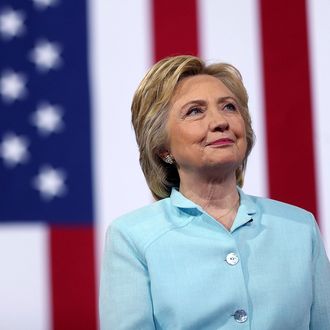
It’s been a good week for Hillary Clinton. The Bernie or Bust revolt that looked so dangerous Monday morning petered out by Tuesday. Bernie Sanders did everything that could be reasonably asked of him to unify the party. There was no unpleasantness over her vice-presidential choice, Tim Kaine. Her occasionally difficult husband subordinated his considerable ego in order to bend his convention remarks to her needs. The politician who stopped her ascent to the White House in 2008 gave a much-praised speech “passing the baton” — and the nation’s attention — to her. But now she has to seal the deal Thursday night in a speech that, for better or for worse, will follow her onto the general-election campaign trail.
So what does she need to do tonight? Here are five things that stand out:
1) Don’t be overshadowed. Whatever else it accomplishes, HRC’s acceptance speech must have enough flash and energy and memorable lines to avoid the problem of the entire commentariat judging it as inferior to earlier speeches, notably those of the Obamas, who both received very high grades. Yes, Bill Clinton’s 2012 convention speech was thought to overshadow Barack Obama’s. But then Obama was an incumbent president running for reelection, which made him more the king receiving his subjects’ praise than a pol being carried toward the finish line by more-talented speakers.
2) Address the emails. HRC’s millstone in the general election is her poor standing on “honesty and trustworthiness,” and the email “scandal,” fairly or not, is at the center of those perceptions. Surrogates have tried to defend her with mixed results. But that’s nothing like the nominee herself owning up to her mistakes clearly and without looking sneaky or defensive, and then contextualizing them in her long history of public service and hyper-responsible behavior. She cannot make the issue go away, but she can at least reduce its salience among voters who are not already in the bag for Donald Trump.
3) Make a strong gesture to Bernie Sanders and his supporters, especially young people. The reluctance of Sanders supporters to get behind her has been a drag on Clinton’s performance in the polls, and a warning sign for November insofar as young voters in particular tend to be marginal voters who before 2004 turned out anemically even in presidential years. That’s the portion of the Obama coalition she needs to worry about most. It’s also important that she keep Green Party candidate Jill Stein from becoming a real temptation to lefty voters. She needs to be fully gracious to Sanders himself and appreciative of his supporters’ passion, and she needs to respect their belief — whether she finds it credible or not — that they represent not just a campaign but a movement that will go on.
4) Identify herself as the candidate of “safe change.” From a messaging point of view, Clinton must carefully balance potentially conflicting themes: She’s the candidate of continuity with Obama, but she’s also the candidate who understands the status quo in this country is unacceptable to a large majority of voters. Her husband labored mightily on Tuesday night to describe her as a “change-maker.” But like he so often did in the 1990s, she needs to project herself as the best option for those who want “safe change” — change that brings everyone along and doesn’t move so rapidly as to threaten instability.
5) Lay out the “two futures” she and Trump represent. It’s sometimes said that presidential general elections usually fall into two categories: a referendum on the incumbent and his or her party, or a choice of two future courses. If Clinton simply offered herself as promising “Obama’s third term,” she might win, assuming his job-approval rating stayed relatively strong and Donald Trump didn’t make himself more respectable. But it’s a significant gamble given high “wrong track” sentiment in the country and residual fatigue over Democratic control of the White House. So the smartest course for Clinton is to lay out very clearly both the direction she wants to take, and the very different and scary direction in which Trump would take America, and then make the fork in the road — the election — as big and clear a choice as possible.
There are other things Clinton might do with the speech. She could continue to stress the history-making nature of her candidacy as the first woman to reach for the White House. But at this point, that’s pretty much a bankable asset for her that has been sufficiently emphasized by many other speakers. She could underline the autobiographical details that her husband so painstakingly presented. But anything beyond establishing her as someone voters can trust with the presidency probably doesn’t matter much now. She could reach for big sound bites and rhetorical flourishes; those never hurt. But they need to reinforce her response to the five challenges above. It’s finally her night, and her night alone. It’s all in her hands now.






























